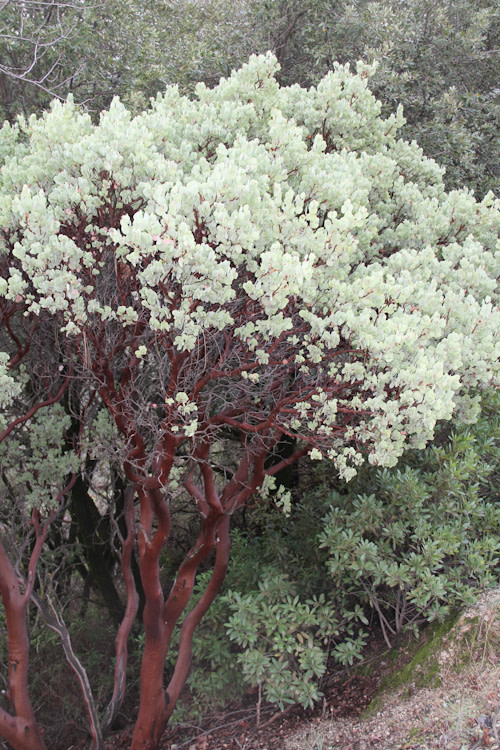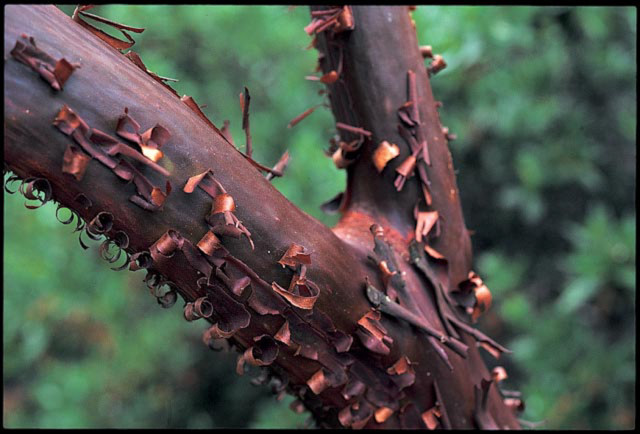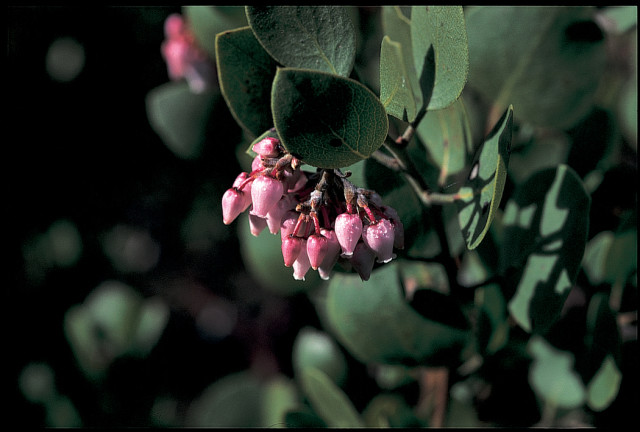Cistus Design's Favorite New Manzanitas for 2013

Arctostaphylos manzanita ssp. glaucescens. Photo courtesy of Cistus Design Nursery
Manzanitas are elegant and iconic West Coast plants that are - finally - gaining the respect and appreciation they deserve.
Native to chapparal zones of western North America from southern British Columbia to central Mexico, they are perfectly suited to the wet winters and dry summers of the Willamette Valley. And while the greatest diversity of species exists in California, there are at least nine beautiful species that are native to Oregon and Washington states.
Manzanitas are drought-tolerant and thus perfect for those who wish to wean their gardens off summer watering. They are also wildlife-friendly, attracting hummingbirds with long-lasting winter and spring flowers brimming with nectar. Most of them are also suitably cold-hardy for Portland.
Manzanitas have a wonderful presence year-round but especially in winter, with a minimalist, unfussy look: sinewy, curved trunks, clean evergreen foliage and those waxy, long-lasting urn-shaped flowers. There is a manzanita for nearly every design scenario: mat-forming groundcovers, shrubs of various sizes and small trees. Form-wise, they can be narrow or wide-spreading. Foliar color can range from rich green to olive green to gray green or even silver. Most species have pretty burgundy, rust, or chartreuse new growth and nearly all have gorgeous burnished copper or red bark that peels and flakes as the plant ages, evolving into one of the most desirable features of a mature plant.

Peeling bark on Arctostaphylos manzanita. Photo courtesy of Cistus Design Nursery
The key to success growing manzanitas is to understand their native habitat. Think of mediterranean climates, with cool, wet winters and dry summers and you have manzanita's ideal conditions. Plant them in well-drained native soil without extra water, compost or fertilizer, preferably on a sunny slope and you'll be doing right by them.
Plant manzanitas from October to March, taking advantage of the winter rains, and you'll get the best root development and less chance of killing the plant with kindness during its first couple of years. (The worst enemy of manzanita is watering in summer during hot weather. So although young plants should be watered during their first couple of seasons in the ground, do try to water before that hot spell and your manzanita will thank you for it.)
Read on for plantsman Sean Hogan’s recommendations on his exciting new collection of manzanitas. A few years of scrambling around on rocky outcrops around California and the Pacific Northwest have paid off. It's hard to go wrong with any members of these groups of plants, but some of his greatest finds have been discovered (and propagated) in the past year. Visit the nursery to peruse his latest selections - some so new they haven't been named yet.

A green-leafed, pink-flowered Arctostaphylos manzanita selection... photo courtesy of Cistus Design Nursery
Arctostaphylos manzanita is a native Californian species growing in the foothills and slopes of the Sierra Nevada and the northern Coast Ranges. Flowers are pink to white and foliage is green to silvery green or sometimes even nearly blue, on a tall shrub or small tree reaching 10-14’ tall. There are several especially attractive, disease-resistant and hardy selections that have been made over the past couple of years – those with silver or blue foliage are always in demand. Find your favorite amongst the current offerings at Cistus Nursery and give it a featured spot in your garden - somewhere it has room to grow into a statuesque, drought-tolerant, hummingbird-attracting small tree. They also look fantastic planted in groups of three or five, if you have the space - and sunlight - for a small shrubbery.
Arctostaphylos x media – A lovely and variable natural hybrid Manzanita which can be found growing in scattered places around western Washington, as well as British Columbia, Oregon and California, where the two parents - taller Arctostaphylos columbiana and the creeping kinnickinnick, A. uva-ursi - commingle in the wild. Plants can look more like one or the other parent but plants are generally 12-15" tall and about twice as wide.. Flowers, appearing in winter, can range from pale to deep pink, set against gorgeous cinnamon brown bark. Orange-red fruit is produced in fall.
Arctostaphylos x media 'Lolo' is an especially choice new selection of A. x media, collected on Mt. Hood. Described by Hogan as “a mini-madrone,” Lolo is a small shrub to 18" tall and wider, with burnished red stems, gray-green leaves and pink flowers from winter to spring. But there are plenty of other selections, each with slightly different characteristics.
While Cistus is the place to find numerous selections of the manzanitas mentioned here, many others can be found through wholesaler Xera Plants’ informative website (their plants are offered at these nurseries), as well as The Desert Northwest in Sequim, WA.
For a detailed article on the manzanitas, written by Xera Plants' Paul Bonine in Pacific Horticulture Magazine, read here.
